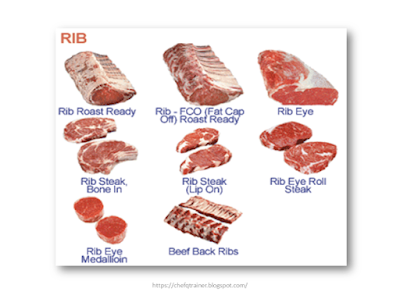Food Commodities Knowledge: Beef Cutting
What is Beef Cutting?
- Knowledge of primal beef cut and the types of pieces obtained from primal cut
- Know and practice how to divide or cut the beef into parts or types of meat.
American Primal Cut
What is Primal Cut
- A primal cut or cut of meat is a piece of meat initially separated from the carcass of an animal during butchering, such as Rib, Loin, Chuck, etc.
- The primal cut is the way to cut into several primary pieces
- Different countries and cultures make these cuts in different ways and names
- Primal cuts also differ between types of the carcass.
- The British, American, and French beef primal cuts have some differences
- For example, English rump steak in British and Commonwealth is commonly called "sirloin" in American English.
Primal Cut Variation
- American primal Cut
- British Primal Cut
- French Primal Cut
- German Primal Cut
- Korean Primal Cut
American Primal Cut
- Chuck
- Rib
- Brisket
- Short Plate
- Flank
- Shank
- Short Loin/ Loin
- Sirloin Butt/ Sirloin
- Round/ Hip
Beef Carcass Sections
1. Chuck
- Best Cooking Methods: Braising, Slow cooking, Stewing, Pot roasting, and Smoking.
- Dishes: Braised Beef Chuck, Smoked Beef Chuck, Grilled Chuck Steak, and Beef Bourguignon.
- Flavor and Texture: Tough, chewy, and flavorful.
- From: Forequarter Part
- Common Cuts: Chuck roll, Blade, Chuck fillet, Ground beef, chuck tender, Flatiron Steak, Shoulder Tender, Eye Roast, Under-Blade Steak.
Beef Chuck Cutting
2. Rib
- Best Cooking Methods: Slow cooking, Roasting, Grilling, Broiling, and Griddling.
- Dishes: Roasted Prime Ribs, Ribeye Steak, Braised Short rib, Broiled Rib Steak.
- Flavor and Texture: Tender
- From: Forequarter Part
- Common Cuts: Rib Steak-Bone in, Ribeye steak, Back rib, Short rib, Rib roll-Lip on bone in (Roasted Beef Rib)
Beef Rib
Beef Rib Cutting
Read: Types of Bread

3. Brisket
- Best Cooking Methods: Braising, Slow Cooking, Smoking, Stewing, and Pot-Roasting
- Dishes: Stewed Beef, Smoked Brisked, Braised Brisked, Soup, and Burger
- Flavor and Texture: Tough and chewy
- From: Forequarter Part
- Common Cut: Brisket flat, Full brisket, Brisket point, and Ground beef.

Beef Brisket
4. Short Plate/ Beef Plate
- Best Cooking Methods: Roasting, Braising, BBQ
- Dishes: Braised Short Plate, Grilled Hangar Steak, Spare Rib BBQ.
- Flavor and Texture: Tender, fatty, and flavorful
- From: Hindquarter Part
- Common Cuts: Short rib, Spare rib, Hangar steak, and Ground beef.
Beef Short Plate
5. Shank
- Best Cooking Methods: Braising, Stewing, Simmering for soup or broth.
- Dishes: Soup, Broth, Consomme, Braised beef shank, and Beef stuffing.
- From: Forequarter and Hindquarter Part.
- Flavor and Texture: Chewy and tough
Beef Shank
Read: Types of Flour
6. Short Loin/ Loin
- Best Cooking Methods: Slow cooking, Roasting, Grilling, Griddling, and Broiling
- Dishes: T Bone Steak, Porter House Steak, Chateaubriand, Grilled Filet Mignon, Pan Seared Beef Medallion, Tournedos Rossini, and Beef Wellington.
- Flavor and Texture: Tender
- From: Hindquarter Part
- Common Cuts: Fillet mignon, T bone steak, Porterhouse, Sirloin steak, Tournedos, Beef tenderloin, and Strip loin.
Beef Short Loin
Short Loin Cutting
7. Sirloin/ Sirloin Butt
- Best Cooking Methods: Pot roasting, Braising, Smoking, Roasting, Grilling, Broiling, and Griddling.
- Dishes: Grilled Coulotte Steak, Smoked Sirloin Butt, Roasted Tri-Tip, Roasted Sirloin, Grilled Top Sirloin, and Grilled Tri-Tip Steak.
- Flavor and Texture: Tender
- From: Hindquarter Part
- Common Cuts: Tri-Tip, Coulotte Steak, Top Sirloin
Sirloin Butt Cutting
8. Round/ Hip
- Best Cooking Methods: Pot roasting, Braising, Stewing, and Smoking
- Dishes: Hungarian Goulash, Stewed Beef, Rendang, Smoked Beef Knuckle, and Braised Sirloin Tip.
- Flavor and Texture: Tough
- From: Hindquarter Part of the carcass after the separation of loin and flank.
- Common Cut: Inside round (top round), Outside round (Bottom round), Knuckle (Sirloin tip), and Ground beef
Beef Round
9. Flank
- Best Cooking Methods: Grilling, Griddling, Roasting, and Broiling
- Dishes: Grilled Flank Steak, Fajitas, and Stir-Fried Beef.
- Flavor and Texture: Tender
- From: Hindquarter Part
- Common Cuts: Flank steak, Sliced beef, and Ground beef.
Beef Flank










































